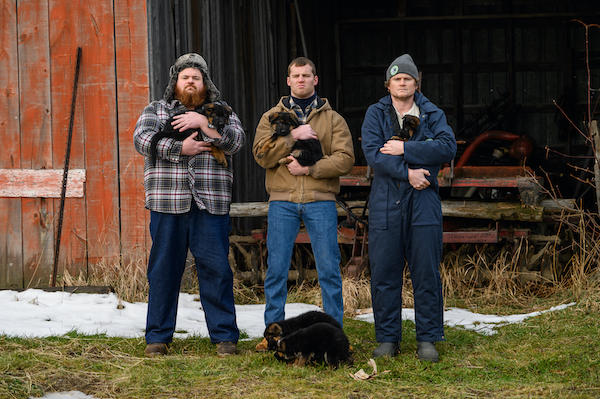The hit comedy LetterKenny actually began as a Twitter account called “LetterKenny Problems.” Then it blew Twitter up. In continuity to the Twitter feed, the introduction unveils a similar introduction, “There is a small town of 5000 people in midwestern Ontario called LetterKenny. These are their problems.” Co-creator Jacob Tierney would describe the engine of the show as characters “venting.”
“A couple of hockey players come up to the produce stand the other day…” vents a character named Wayne (co-creator Jared Keeso), who is the fourth-wall-breaking star of the ensemble cult series that is arguably crossing over into mainstream comedy.
“I’ve never really tried to define [the comedic style] of LetterKenny,” said Tierney, who plays Glen on the show, “But it’s definitely an enormous amount of wordplay. We love wordplay – we love long stories – mixed in with kind of a flat physical and visual delivery.”
The series, which takes place in a small town made up of “hicks, skids, hockey players and Christians” is based loosely on Keeso’s hometown. In addition to the Twitter account, Keeso also created several YouTube videos to preview what’s now the show. The series stands out because it presents life in a small town as anything but boring.

Jacob Tierney
“I think what we’re trying to do is make it feel as warm and real as possible—as human as we can,” added Tierney. “I’m not sure if our show has made an impact to say this is what small-town Canada is like, but I think there is a universality to LetterKenny.”
He continued, “You can replace hockey with any other sport. I think every community has a drug problem. There’s agriculture going on. It’s transferable. But the more specific we get, the more universal things become. Then you find the truth.”
Violence & Masculinity
Within this truth, the show tackles issues like masculinity in the modern era. According to Tierney, Keeso feels like the violence in the show is a reflection of the reality of small town life. “I think a lot of what our show deals with is masculinity and frankly, non-toxic masculinity. It’s gentlemanly. There’s a handshake at the end of every fight.”
“Violence is not a means of which to subjugate. It’s never cruel. It’s usually a beef that needs solving and then they have a beer together and they’re over it. LetterKenny is a self-policing town. There’s no cops in it. So it’s really about people respecting each other, violence not being gratuitous, but it’s a rough place too.”
Within this viewpoint, Tierney said, “I think experiencing non-toxic masculinity is very feminine. In the first episode, it’s about whether Wayne is the toughest guy in LetterKenny. We find out that he is, but what does he do with that power? He defends people. He respects them, even if he doesn’t like that. I think that that’s one of the hallmarks of the show: intolerance for bullies.”
Structure Not Required
Now entering its ninth season, LetterKenny continues to focus on character. “We don’t have a superstructure. We went back to the well, which is our characters. We dug into them more. Gave them fuller lives. Flushed them out. Gave them context. That led to us finding more and more funny things.”
The show tries to avoid heavy storylines. Instead, they focus on character and always make sure at least three episodes per season work as complete standalones. “The larger storylines are very simple, like ‘Wayne’s single’ or ‘Wayne’s dating’ or ‘Katy’s single’ or ‘Katy’s dating.’ They’re very basic so we’re not getting too bogged down with story details that ultimately we don’t find interesting because our show is about people sitting around shooting the shit. The more we can do that, the better.”

Wayne (Jared Kesso) & Katy (Michelle Mylett), shown. Photo By Amanda Matlovich
Tierney credits the humble comedy of the show as a combination of good writing and good actors. “If you get to know your actors, and you get to know what they’re good at, you start writing to their strengths, I don’t think you can go wrong.”
In addition to these simple rules, the creators also rely on gut instincts more often than not. “It’s a lot of gut feelings of, ‘Do we think this is funny enough to dig into?’ Then, we do. Or, ‘Do we need to pull the chute?’ In terms of the characters, we love these characters. We love exploring them and we love their interactions. I think that’s where the funniest stuff comes from.”
Distinctive Dialogue
For anyone who has watched LetterKenny, the love of character is clear. Meanwhile, the dialogue almost requires listeners to tune in to a new wavelength, almost like picking up an ear for Shakespearean monologues.
“I used to call it Dumb Pinter. No one ever talks for a very long time, but it’s very rhythmic and it’s very specific. There is an iambic pentameter quality to it that, so if you fall into the rhythm, you’ll hit the jokes. It’s almost like a get-out-of-jail free card. Do the right thing on the page, do it at the right pace, and most of the time, it will be victorious,” declared Tierney.
Tierney and Keeso both love language, so they love to dive into the wordplay, but also the repetition (every episode follows the greeting, “How are ya, right now? Good-n-you? Not so bad…” multiple times), so it really is a show for the actors.”
“If they dig into the right rhythm or pattern, the comedy will come from it. I think some of them find it liberating. It’s not improv-based. The scenes are so long that the idea of improv would be exhausting—especially the scenes [with Wayne, Daryl and Dan] where they’re talking forever and ever and ever.”
This crazy banter is one thing that fans love about the show, but it also makes a second or third viewing as much fun as the first. “There is so much that gets left on the table where maybe you didn’t hear it or pay attention the first time you see it. I think that makes a rewarding second viewing.”
Jacob Tierney confessed his grandparents actually watch the show in Closed Captioning because they can’t understand what’s being said on the screen.
Story Concepts
“Whether an idea belongs in the show or not is based on gut instinct — or trial and error. We’ve written episodes that we’ve completely disregarded because we felt like we didn’t hit or didn’t get what we wanted out of the storyline.”
One example of a successful true-story-turned-episode was the episode in Season 4 called “A Fuss at the Golf Course.” According to the description, there’s a fight to defend the majestic Canada goose at the local golf course, which means a brawl between the Hicks and the McMurrays.
“That happened at Jared’s dad’s golf course,” admitted Tierney. “There was a goose problem. So we take things like that or from small town life or from other people’s lives or sometimes things that are slightly topical, but then it comes down to sex and boob jokes, ultimately. That’s our sweet spot.”
Aside from the longer story, each individual episode also has a cold open that’s basically as unrelated as any storyline as a Simpsons episode opening. “They’re very different — especially the first one of a new season. We have lots of ideas we pass back and forth before we decide what we’re going to do. Often, it will be something like Jared coming in, saying, ‘Okay, I want to do the alliteration of winter’ or he’s got a rap for Katy. We do care a lot and the first cold open of a new season is always very specific.”
No TV Writers’ Room Required
All of this, of course, falls down to the two creators, who claim they don’t use a TV writers’ room. Instead, they get together and break the season, then figure out the previous season’s cliffhanger, discuss whether or not the boys (Reilly and Jonesy) are playing hockey, who’s single, who’s dating, and then they write the first two and last two episodes.
Then, they offer their other writers prompts like “do a Halloween episode” or “do a spelling bee” for standalone episodes. And, between all of this, they also let writers pitch episode ideas. “Then, people write first drafts, including me, and then it all goes to Jared, and Jared rewrites everything.”
For both Keeso and Tierney it’s all about the comedy and joy of the work. “Jared and I bonded right away and we got along so well because we made each other laugh. At the end of the day, we’re very close friends and doing it together, how handmade it is. You see what makes us laugh and that’s the spark. Everything you’re seeing has made the two of us laugh. We try very hard to make a funny show. I’m not trying to teach anybody a lesson about life. I’m not trying to educate or inform. I don’t think LetterKenny is the venue. We want to create a funny show that lives in a happy place.”

